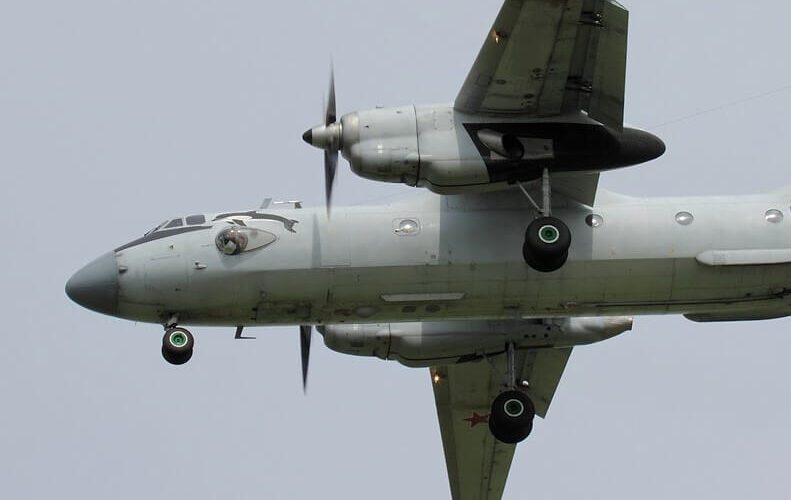As the civil war in Sudan rages on, the Sudanese Air Force has resorted to using some of its Soviet-built Antonov transport aircraft as makeshift bombers to increase its firepower against the Rapid Support Force (RSF), a paramilitary group that has been accused of committing atrocities and human rights violations in the country.
The Sudanese Air Force has a fleet of Russian-built Antonov transport aircraft, including six An-12s, two An-26s, and eight An-30s. These aircraft are mainly used for medium transport, para-dropping, and reconnaissance missions, but they can also be modified to carry bombs and drop them over enemy targets.
According to sources, the Sudanese Air Force has installed a removable roller conveyor on the guide rails in the cargo bay of some of these aircraft. The conveyor can fit four 500-pound bombs, which are rolled out of the cargo hatch when the aircraft flies over the target area. The bombs are unguided and have a high margin of error, making them indiscriminate and illegal under international law.
The Sudanese Air Force can also mount bombs on the wings of the transport aircraft, increasing their payload and range. However, this also reduces their maneuverability and speed, making them more vulnerable to anti-aircraft fire and fighter jets.
Adapting transport aircraft to serve as bombers is nothing new. In the past, these types of aircraft typically came about because of expediency, above all during conflict. Soviet-designed transports have long been able to drop bombs as a secondary mission. Even quasi-civilian transports once rolled off Soviet production lines with bomb shackles and defensive gun turrets attached. If an air force finds itself with a shortage of bombers, it could always add offensive weapons to transport aircraft—even if these planes lack the means to accurately deliver such payloads.
This is not the first time that the Sudanese Air Force has converted its Antonovs into bombers. During the war in Darfur in 2003, the Antonovs were notorious for bombing villages and civilians in the western region of Sudan, causing widespread death and displacement.
Beginning in the early 1990s, primarily Soviet-designed transports—colloquially known as “Antonov bombers”—have waged a little-known and particularly bloody war in Sudan. Many people in Darfur learned to recognize the sound of the Antonovs and to flee and hide from their bombs, which were often filled with shrapnel and high explosives.
Initially, the Sudanese air force dropped Soviet-made bombs from the rear ramps of An-12 and An-26 transports. Later, Khartoum resorted to locally-made bombs—typically fuel drums filled with explosives and shrapnel.
Most remarkably, Sudan hired civilian operators—both local and foreign—who used the aircraft against the rebel Sudan People’s Liberation Army. On several occasions, the Antonov bombers attacked humanitarian relief centers.
The use of the Antonovs as bombers reflects the desperate situation of the Sudanese Air Force, which lacks modern and effective combat aircraft and faces a formidable adversary in the RSF, which is backed by Saudi Arabia and the United Arab Emirates. The RSF has reportedly destroyed several Antonovs on the ground and in the air, reducing the Sudanese Air Force’s operational capability and morale.
Some of the Antonovs destroyed on the ground are four An-12 transport aircraft destroyed at Khartoum air base, one An-26 transport aircraft and one damaged at Merowe, three An-26, An-30/32 transport aircraft, and one An-72/74 transport destroyed at Khartoum AB.
Also, on October 2918, a Sudanese Air Force (SAF) Antonov An-32 and AN-26 collided on the runway at Khartoum International Airport resulting in the total write-off of both aircraft.
Although, despite this significant loss, the Sudanese Air Force still possess sufficient capabilities to carry out it’s responsibility. The Sudanese Air Force relies greatly on Chinese and Soviet era aircraft. There are still several other combat capable aircraft; mostly of Soviet and Chinese-build in it’s inventory, however, their serviceability and airworthiness may be in question. Other aircraft in it’s inventory includes MiG-21s, MIG-23s, Nanchang Q-5, Shenyang J-6, Chengdu J-7, Sukhoi Su-24, and Sukhoi Su-25.
The RSF can still shoot down the repurposed Antonov and other aircraft since it possesses anti-aircraft capabilities. Recent revelations from the U.S. Department of the Treasury’s Office of Foreign Assets Control (OFAC) disclosed that Wagner Group, a Russian private military contractor, has been involved in supplying surface-to-air missiles to Sudan’s Rapid Support Forces (RSF) to combat the Sudanese army. Although the report did not specify the type of surface-to-air missile system Wagner Group supplies to the RSF, however, it may likely be man portable (MANPAD), or short range air defence system.
Subsequently, in May, Rapid Support Forces (RSF) shot down a MiG-29 fighter jet over Khartoum, at the time, the Sudanese Air Force deployed its MiG-29 fighter jets in support of the Sudanese Army.
The ongoing conflict in Sudan has resulted in a deadlock, with both sides making limited progress. While the RSF controls a significant portion of the capital, it has been unable to secure complete dominance.
The opposing factions, which include various rebel groups, continue to mount resistance, resulting in a prolonged stalemate. The conflict has inflicted significant humanitarian suffering on the Sudanese population, with displacement, violence, and economic instability being widespread.
Sudan’s military in June initiated a forceful offensive against the paramilitary Rapid Support Force (RSF). This offensive aims to retake key areas that were under the control of the RSF, a powerful and controversial paramilitary group in the country. With massive artillery strikes and air raids targeting strategic RSF installations and troop clusters.
